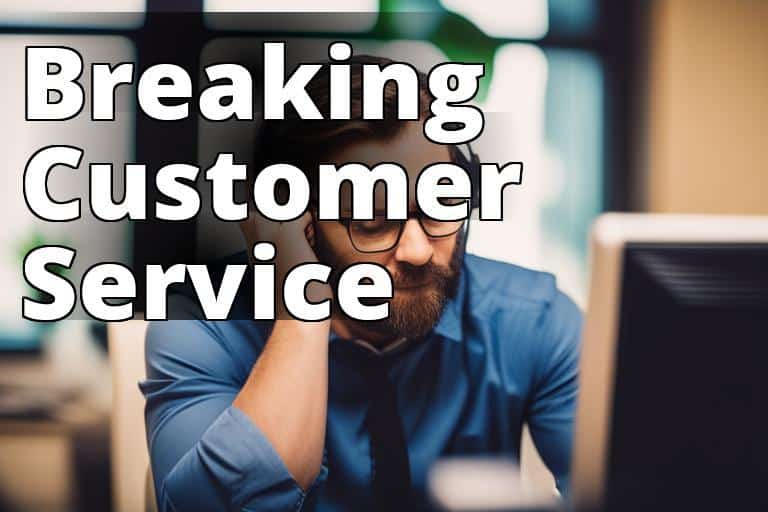Boosting Customer Service with Contact Center Software
Implementing customer contact center software can seem like a daunting task, especially when you’re not fully aware of its potential benefits.
Browsing through various forums and LinkedIn posts, you might come across business owners expressing concerns about the cost-effectiveness and efficiency of such systems.
“You can’t improve customer service without investing in advanced tools, but how do we ensure these investments yield desired results?” This concern is valid yet addressable.
The rapid evolution of technology has brought forth innovative solutions that are disrupting traditional customer service methods. The rise of sophisticated customer contact center software is transforming the way businesses interact with their customers while improving operational efficiency.
The impact on customer satisfaction is real.
Table of Contents:
- The Importance of Effective Customer Contact Center Software
- Key Features to Look for in Call Center Software
- Choosing Between Hosted vs Cloud-Based vs On-Premise Software
- Integrating Your Call Center Software with Other Business Tools
- Evaluating Pricing Models for Call Center Software
- Best Practices in Utilizing Call Center Software
- FAQs in Relation to Customer Contact Center Software
- Conclusion
The Importance of Effective Customer Contact Center Software
In the fast-paced world of business, customer service is more than just a buzzword. It’s about establishing trust and building enduring relationships with your customers – often starting with phone support.
However, delivering efficient phone support can be an uphill task without the right tools at hand.
Traditional methods may prove to be time-consuming and expensive due to inefficiencies in call routing and lack of context during interactions. That’s where call center software becomes instrumental.
This type of software provides solutions that streamline these processes by efficiently routing calls to appropriate agents while offering valuable insights into each customer’s history and needs. The outcome? Increased efficiency, reduced costs, enhanced customer experiences – all leading towards bolstering your brand reputation.
An Omni-Channel Strategy: A Key Component
A truly effective call center solution extends beyond traditional voice-based interactions; it supports an omni-channel strategy as well. With multiple platforms available for customers to interact with businesses today – from social media channels to live chat options on websites – consistency across channels has become paramount.
This implies ensuring that regardless of how a client chooses to engage with your company – via telephone or otherwise – they receive consistent high-quality service every single time.
Finding Balance Between Efficiency & Cost
Naturally, there are cost implications associated with implementing such sophisticated systems, but consider this:
If you don’t have efficient call handling procedures in place, you risk losing potential leads due to poor first impressions or even existing clients who become frustrated by subpar experiences.
As we delve deeper into understanding what features one should look out for when selecting suitable contact center software, let us also examine some key aspects around choosing between hosted vs cloud-based vs on-premise software next.
Effective customer contact center software is a game-changer in the business world. It not only streamlines phone support but also fosters trust and enduring relationships with customers. An omni-channel strategy ensures consistency across all platforms, while balancing efficiency and cost can safeguard against losing potential leads.
Key Features to Look for in Call Center Software
Selecting the right call center software is like piecing together a puzzle. Each feature, from omnichannel communication capabilities to interactive voice response (IVR), automatic call distribution (ACD), and flexible call routing options, plays its part in creating an efficient customer service machine.
Omnichannel Communication: The Consistency Kingpin
The power of omnichannel communication cannot be overstated.
In this modern digital era, customers are engaging with companies on various communication channels – such as phone calls, emails, social media networks or live chats on the website. Omnichannel communication ensures that no matter where they reach out from, they receive consistent high-quality service. This article further elaborates how this feature can elevate your customer experience game.
Interactive Voice Response (IVR): Your Automated Receptionist
An IVR system acts as an automated receptionist guiding callers through pre-recorded prompts. It helps ensure incoming calls are directed appropriately based on caller responses, thereby improving efficiency and enhancing satisfaction levels by reducing wait times.
Automatic Call Distribution (ACD): Balancing Workloads Effectively
If you’ve ever wondered how inbound calls get distributed among available agents efficiently, ACD systems hold the answer. They use predefined rules such as skill-based routing or round-robin method, ensuring fair workload distribution amongst team members. Understanding their workings could prove beneficial while selecting contact center software for your business needs.
Having understood these key features, it becomes easier to make informed decisions about what kind of contact center solution suits best for your specific requirements. Now let’s move forward towards understanding different types of hosting models, i.e., hosted vs cloud-based vs on-premise solutions.
Choosing Between Hosted vs Cloud-Based vs On-Premise Software
The selection of call center software for your enterprise can be a tricky task, requiring the consideration of whether to go with hosted, cloud-based, or on-premise solutions. Each type has its unique benefits and potential challenges.
Diving into the Benefits of Hosted Software
A hosted software model means that all data servers are stored and maintained off-site by your provider. This approach offers cost savings as it eliminates the need for large upfront investments in hardware or IT infrastructure. Moreover, updates and upgrades are typically handled by providers, which allows you to focus more resources elsewhere.
The Flexibility of Cloud-Based Solutions
Cloud-based software, meanwhile, provides unmatched flexibility and scalability compared to other options. As your business grows over time, so too can your contact center capabilities without requiring substantial capital expenditure. Additionally, these systems often feature cost-effective pricing models, allowing for more budget flexibility than traditional licensing agreements.
Weighing Up The Advantages Of On-Premise Platforms
If maintaining control over data security is paramount, then an on-premise solution may suit best. These platforms allow businesses complete oversight over their own data storage facilities, offering greater assurance regarding privacy protection measures implemented at every level. Furthermore, customizability is another key benefit associated with such setups. Unlike hosted or cloud-based alternatives where customization might be limited due to shared resources, this isn’t usually a concern when deploying proprietary server infrastructures. However, keep in mind it also requires ongoing maintenance and dedicated IT staff members.
In conclusion, selecting between hosted, cloud-based, and on-premise call center software depends largely upon understanding how each aligns with specific needs within the context, evaluating factors like initial investment costs through operational expenses, as well as considering issues around scalability requirements versus desired levels of control. These aspects must play a final decision-making process. The chosen software will serve as a crucial tool in driving customer service
Picking the right call center software boils down to your business needs and resources. Hosted solutions save on upfront costs, cloud-based ones offer scalability with a pay-as-you-go model, while on-premise platforms provide data control and customization but require dedicated IT staff.
Integrating Your Call Center Software with Other Business Tools
You’ve chosen the perfect contact center solution for your business, but now it’s time to fully utilize its features. One way to do this is by integrating your call center software with other essential business tools.
The key lies in CRM integration for customer context.
This process entails combining data from multiple sources into a single, readily accessible system. It not only streamlines operations but also equips agents with crucial information about customers’ past interactions and preferences, enabling them to deliver personalized service that enhances overall customer experience.
CRM Systems Integration
Your choice of popular CRM systems like Salesforce or HubSpot can integrate seamlessly with most call center software options available today. This seamless sharing of data between platforms provides necessary contextual support when dealing with clients.
Apart from boosting agent productivity through reduced search times across multiple platforms, such integrations foster stronger relationships via improved communication strategies tailored specifically towards each individual client based on their interaction history.
Merging Marketing Platforms
Another vital aspect includes merging marketing platforms like Mailchimp or Sendinblue. Such an amalgamation alongside your contact center system allows better coordination between sales and marketing teams. Ensuring alignment in messaging throughout all stages of the buyer journey helps create a cohesive brand image perceived by potential leads and existing clients alike.
Cohesion With POS Systems And Calendars
Last But Not Least Is The Merger Of Point Of Sale (POS) Systems Like Square With Your Contact Center Software Can Prove Highly Beneficial In Retail Settings Where Immediate Access To Purchase Histories Is Essential For Providing Prompt And Accurate Customer Support. Furthermore, Integrating Calendars Such As Google Calendar Or Outlook Calendar Ensures That All Scheduled Calls And Meetings Are Seamlessly Synchronized Across All Relevant Platforms, Thereby Reducing The Risk Of Overlapping Appointments Or Missed Interactions.
In Our Next Segment, We’ll Del
Unleash your contact center software’s full potential by integrating it with CRM systems, marketing platforms, and POS systems. This fusion not only streamlines operations but also provides crucial customer insights for personalized service, boosts agent productivity, ensures consistent messaging across all stages of the buyer journey and reduces risk of missed interactions.
Evaluating Pricing Models for Call Center Software
As you navigate the landscape of call center software, one crucial aspect to consider is pricing. The cost structures associated with these solutions can vary significantly based on factors such as the number of agents and required features.
A common approach: Per-User Pricing
The per-user or per-seat model is frequently used in this space. This method charges according to how many users will be utilizing the system. It’s worth noting that not all user licenses are created equal – some may grant full access while others limit certain functionalities.
An alternative route: Usage-Based Pricing
In contrast, usage-based models charge depending upon your actual use – from minutes spent on calls to messages sent and received. For businesses experiencing fluctuating customer service demands, this could prove to be a more flexible option since it ensures you only pay for what you need.
Navigating Hidden Costs
When considering pricing models for call center software, don’t just focus on upfront costs; remember potential hidden expenses too. These might include setup fees, training expenditures, integration with existing systems, maintenance over time, etc.
Making Cost-Savvy Decisions
To make informed decisions about contact center solution expenditure, first pinpoint key needs then compare how well each vendor meets them against their respective price tags. Also, bear in mind scalability – if the business grows rapidly, will there be a significant increase in cost? Lastly, take into account return on investment (ROI). High-quality customer service often leads to increased sales and retention rates, thereby offsetting the initial outlay over time.
Trial Periods And Demos:
A smart way to evaluate whether a particular piece of software is the right fit without committing a large sum of money upfront is taking advantage of trial periods and demos offered by many vendors. These provide hands-on experience with the tool’s interface and capabilities, helping determine its suitability for the organization before making a purchase decision.
Navigating the complex terrain of call center software pricing doesn’t have to be a daunting task. With thorough research and understanding of your unique
Don’t let call center software costs catch you off guard. Consider per-user or usage-based pricing, watch out for hidden expenses, and weigh the ROI. Test drive with trials and demos before buying. A savvy approach can lead to cost-effective customer service solutions.
Best Practices in Utilizing Call Center Software
Once you’ve made the investment in a contact center solution, it’s essential to make use of its features to maximize efficiency and improve customer satisfaction. By doing so, you can significantly boost operational efficiency while enhancing customer satisfaction levels.
Dive Deep Into Advanced Analytics Capabilities
The modern call center software comes equipped with powerful analytics capabilities that allow businesses to track key performance indicators such as average handle times or first-call resolution rates. These metrics provide insights into areas of improvement and help formulate strategies aimed at bettering service delivery.
If your data reveals high average handling times, consider introducing training programs focused on improving agents’ problem-solving skills – this could lead to quicker resolutions and happier customers.
Optimize Your Outgoing Calls Strategy
A well-thought-out strategy for outgoing calls is a cornerstone of any successful contact center operation. This involves determining optimal timings for outbound calls based on historical data or customer preferences. Modern call centers often feature predictive dialers which use algorithms to anticipate when an agent will be available next, thus minimizing idle periods between conversations. Efficiently utilizing time while making sure no leads get lost is the main aim.
Prioritize Customer Experience Across Channels
Your ultimate goal should always revolve around delivering excellent experiences across all communication channels used by customers. To achieve this, ensure seamless integration among various platforms within your chosen software. This would ensure each interaction feels consistent from a customer’s perspective regardless of whether they’re reaching out via phone, email, social media, etcetera. Remember, it’s important that agents have comprehensive caller information before picking up every single incoming call.
Maintain Regular Training Sessions
Last but certainly not least is the importance placed upon regular staff trainings for those who utilize these tools daily – your support team. It’s vital that they fully comprehend the workings behind each feature and stay updated regarding new additions/changes made over the course of time. Consistency across the board ensures smooth sailing during actual interactions with clients and allows them to serve efficiently using all possible tools at their disposal.
Maximize your contact center software by diving into analytics, optimizing outbound call strategies, prioritizing customer experience across channels, and maintaining regular staff training. These practices will not only enhance operational efficiency but also elevate the level of customer satisfaction.
FAQs in Relation to Customer Contact Center Software
What is contact center software?
Contact center software is a tool that helps businesses manage customer interactions across various channels such as phone, email, live chat, and social media.
What kind of software do call center agents use?
Call center agents typically use CRM systems integrated with telephony or VoIP solutions to efficiently handle calls and provide quality service.
What is the best call center software solution?
The “best” solution depends on your business needs. Popular options include Five9, Talkdesk, RingCentral Contact Center, and Genesys Cloud.
What is the difference between a call center and CRM?
A call center handles communication through voice calls, while CRM (Customer Relationship Management) tools track all interactions with customers across multiple channels, including calls.
Conclusion
Understanding the importance of customer contact center software is your first step towards enhancing service delivery.
This software, with capabilities like multi-channel communication and IVR systems, can be a great advantage for your organization.
The decision between hosted, cloud-based, or on-premise solutions depends largely on your specific needs and resources.
Integration with other essential business tools is crucial to streamline operations and maximize productivity within your call center.
Evaluating pricing models helps you find a solution that delivers value while fitting into your budgetary constraints.
Above all, knowing how to utilize these features effectively will ensure optimal return on investment.
If you’re ready to revolutionize customer service in your business using innovative software solutions, I invite you to dive deeper into my personal experiences shared over 35 years in this field at Chrisvassiliou.com. You’ll learn more about leveraging technology for better leads and improved customer satisfaction. Let’s embark on this journey together!



